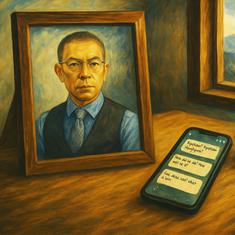The museum will recognise and celebrate the women of the East End who have shaped history, telling the story of how they have been instrumental in changing society. It will analyse the social, political and domestic experience from the Victorian period to the present day.
So the “Museum of Women’s History” turns out to feature exhibits about murdered women. More than that, like many other products designed to cater to those fascinated by the Ripper story, it risks elevating its chief protagonist to a heroic status and propagating dangerous myths about male sexual violence (as Judith Walkowitz has so expertly explained).
But such concerns are rarely aired about Ripper tours in Whitechapel. Most interesting about this story is that it seems that a planning application for a Jack the Ripper museum is something that necessitates subterfuge. And the proprietors were right to be so furtive. Remarks made by one community campaigner are telling: “I feel offended by this museum of the macabre … The sign outside suggested it would be a gruesome attraction.”
Jack the Ripper museum in Cable St sought planning permission by saying wld 'recognise & celebrate women of East End' http://t.co/Zkuss415x7
— Catherine Baker (@richmondbridge) July 29, 2015All this feels, well, very Victorian, doesn’t it? Museums of curiosities, delighting in the macabre and the squalid. But the outcry that this surprise reveal generated reminded me overwhelmingly of a very similar occasion, ironically from the time of the Ripper murders. In 1888 another local was outraged at another Jack the Ripper museum. So much so that he wrote a letter to the editor of the Pall Mall Gazette to express his disgust:
Outside it is a picture of the unfortunate women murdered by what the slummers call ‘the bloody demon’. Inside it is a cellar full of horrors … A smell of death rises into your nostrils, and you feel as if your throat were filled up with come poisonous fungus.
This parallel expression of dismay at a doppelganger Ripper museum is particularly apt because it’s a product of the moment when we began to be furtive about our morbid interests, when we began to be squeamish. This history is only 130 years old.
#JackTheRipperMuseum is #OpeningSoon #Follow for more details! #EastLondon pic.twitter.com/G4sBmSlGJX
— JackTheRipper Museum (@RipperMuseum) July 23, 2015Perverse predilections
Humans have found entertainment in violence for aeons. The Romans had their gladiators. The Elizabethans revelled in bear baiting. And when the Victorian obsession with collecting got going, this morbidity was simply transferred to the museum setting – much like this latest 21st-century murder museum, though the primary interest then was in the representation of recent and topical murders rather than historical ones.
The most famous, of course, was Madame Tussaud’s Chamber of Horrors, a prominent gallery located within her commodious waxworks exhibition in Baker Street. Just about everyone loves looking at life-size models of famous people, and even more so in an age before photography. But large crowds were especially drawn by the effigies of murderers – sometimes accompanied by their victims, and sometimes in the act of committing the evil deed – which had occurred only weeks before.
Madame Tussaud also went to great lengths to obtain relics from the crimes to accompany the effigies. The effigy of the Stanfield Hall murderer, James Rush, was dressed in the suit worn by his namesake for his execution, which Madame Tussaud purchased from the hangman for 70 guineas. The investment paid off; the extra admissions to see the Rush effigy generated a profit of £1,500. The money came from “respectable” Londoners, the middle and upper classes; the admission price excluded most working people. There are many other examples of high-priced exhibitions of contemporary murders which attracted large crowds. The great and good could even be seen at the sites of murders seeking souvenirs and memorabilia.
Working people were not excluded. Cheaper and more accessible rivals to Madame Tussaud’s flourished, in London especially. Charles Dickens described one such exhibition in an old tumbledown house in the New Cut in 1866, for which admission was just one penny. Working men, boys, girls and domestic servants pausing between errands gathered in what was little more than a shed to listen to a “gloomy lad” give an account of the crimes with which the figures were associated. “A dirtier, or a more wretched, ragged and in the last degree mean and miserable exhibition, it is impossible to conceive,” wrote Dickens. And narratives of recent murders were not just told through wax. These museums and exhibitions were supported by melodramatic theatrical productions and an especially graphic print culture.
Supping on scandal
Yet all this was to change during the 1870s. Graphic entertainments based on recent gruesome murders began to become much less prominent. Madame Tussaud’s addition of new effigies to her Chamber of Horrors slowed down – and while the balance in the Chamber slowed turned in favour of those figures receding from living memory, the Chamber itself gradually became a much smaller part of a broader and grander exhibition. Violent entertainment did not disappear, but its more outrageous forms were successfully relegated to the margins, enjoyed by the minority, or, as contemporaries liked to think, the rough.
The discovery of mutilated bodies of five women in the autumn of 1888 created a sensation, but of a very different sort. Whereas before this might have manifested itself in gruesome museums or plays recreating the murders, Madame T (or rather her sons) did not rush to illustrate the murders, or even just the victims, in wax. Those who did were typically proprietors of crude exhibitions that often didn’t survive more than a few weeks.
Instead audiences, both high and low, supped on the horrors printed in the newspapers, which had vastly increased their crime reporting. Many people turned their hand to armchair detective work (including, some say, Queen Victoria). The obsession with crime, violence and entertainment was still there, but in a new, more “respectable” location.
Both the sentiment and the press coverage belonged to a very new age in the representation and consumption of violence: one that continues today. People still devour the gory details of topical crimes – but now they do so through the safe and distancing mechanism of the newspaper – or the screen. The BBC’s Ripper Street is about to be resurrected, after all.
This article was originally publiched on The Conversation.










